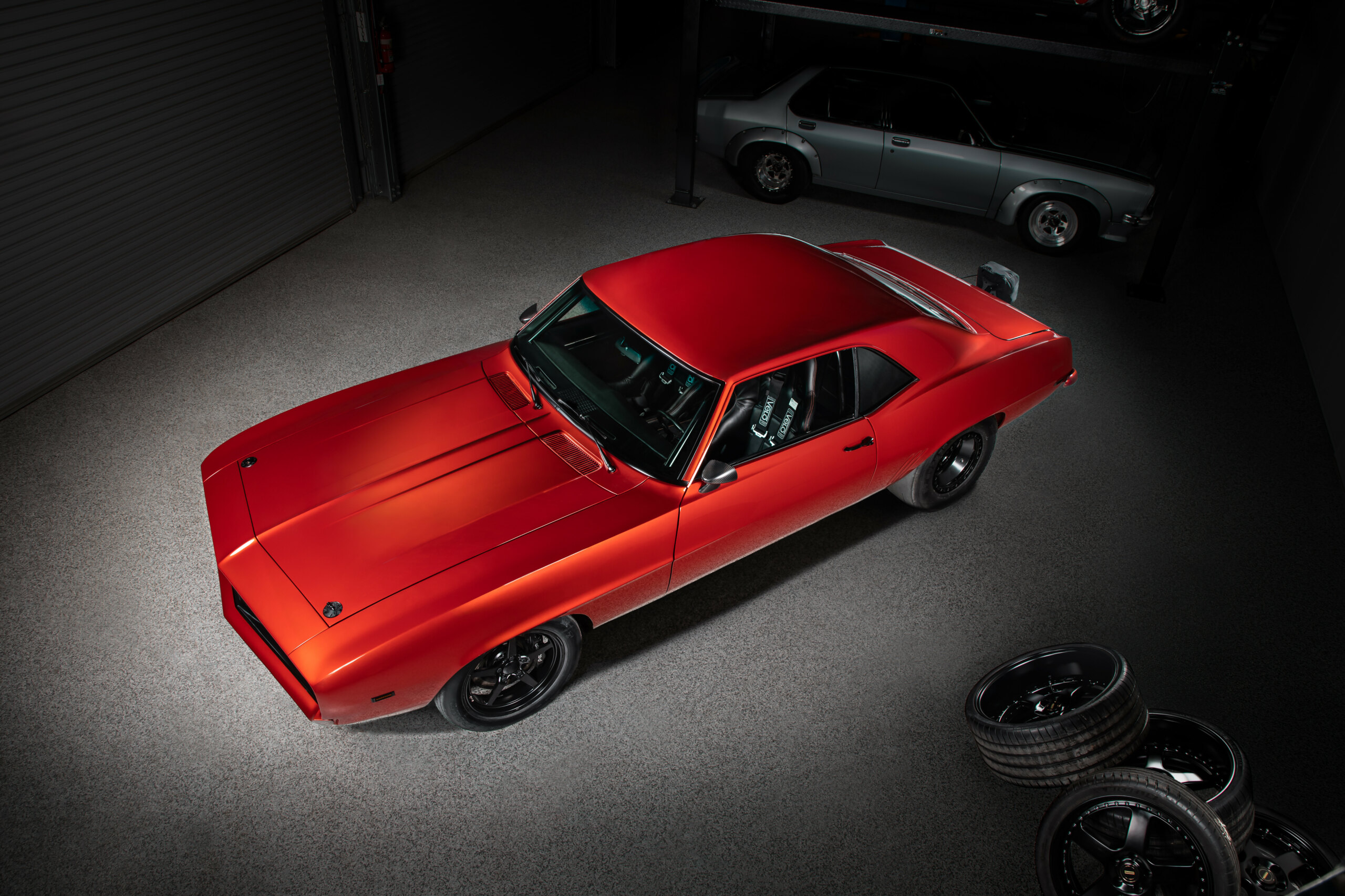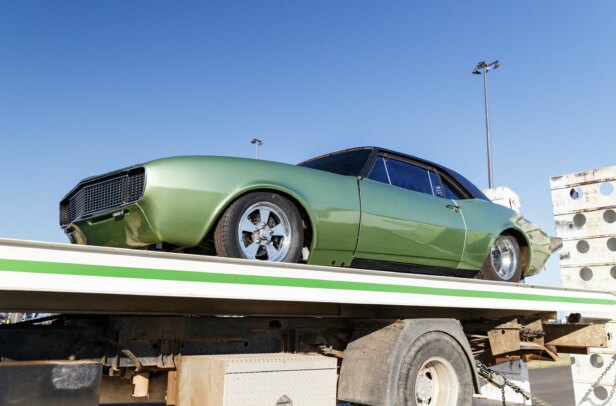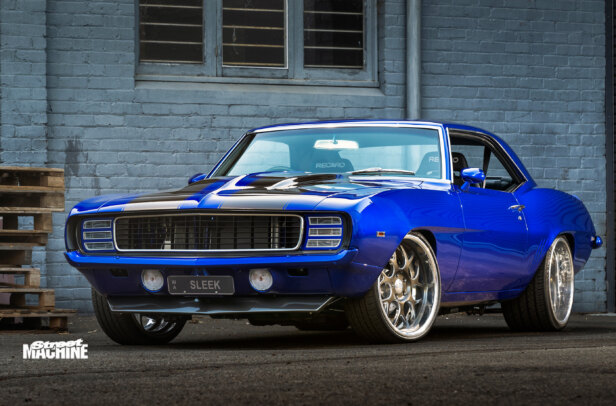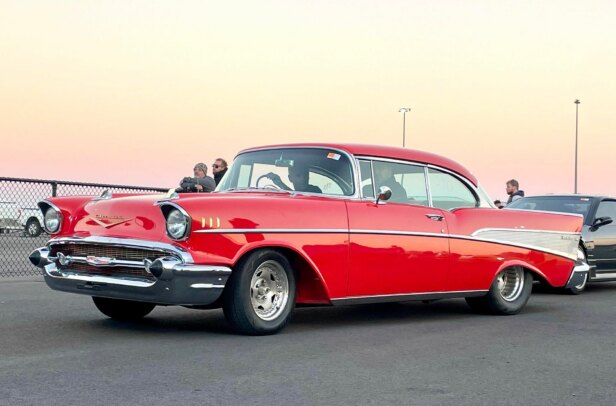Originally launched as a response to Ford’s genre-busting Mustang, the Chevrolet Camaro has become one of the most popular American cars to modify thanks to its adaptability to a wide variety of build styles. Whether it’s a pro street toughie, pro touring corner-carver, neat streeter or drag sled – or even a lowrider or 4×4 – someone’s done it to a Camaro. So how do you build a standout ’Maro these days? If you’re Queensland’s Glen Finegan, you do it by accident. His 1150hp, twin-turbo LSX-powered 1969 F-body started off as a Drag Challenge build, before hurtling out of control into a supremely detailed showpiece.
First published in the April 2022 issue of Street Machine
“I had the old Penzoil chopped-top ’55 Chevy and was going to put a twin-turbo LS in it, but I realised it was way too heavy for the drag racing I wanted to do,” Glen begins. “I ended up buying a Nelson Racing Engines 427ci LSX and then had to find a car that could house it and be legal. As Camaros came out with a 427 [see more, below], I figured that was a great option. One of my best mates had imported this Camaro 15 years earlier and it had been sitting around, so I bought it back in 2014.”
The shell may have been rust-free, but that doesn’t mean it was ready for colour coats. After the Ron Rhodes radiator support, Speedtech rack-and-pinion front end and mini-tubs liberated the required real estate, Ralph Porteous and the team at Fastlane Panel & Paint got the shell straight and hosed down in PPG Sakhir Orange.
“I have to give Ralph a lot of credit for the job he’s done on the body,” says Glen. “We spent hundreds of hours on the shell – including Saturdays and Sundays – for months on end, and the result is amazing. It turned out far better than I’d ever intended, so we decided to paint underneath it instead of stoneguarding it.”
It is easy to spend all your time looking at the schmick bodywork, but this F-body isn’t just a pretty face. Under the bonnet is the aforementioned twin-turbo 427ci LSX built by Nelson Race Engines (NRE) in the land of bald eagles and bourbon.
Based around a 9.7in-deck-height GM LSX block, it’s packed with spice like Callies Ultra rods and a 4.250-in Callies 4340 crank matched to forged JE slugs and a custom-ground Comp cam. Up top, All Pro 215 heads are capped by a dual-injector NRE Alien/Anteater intake manifold, which also cops the boost after it runs through a pair of air-to-air intercoolers.
“I went for the 72mm turbos,” says Glen. “I was going to go 88s, but Tom at NRE said they’d be too lazy on the street. I thought, if I’m going to make power in a street car, I want it to be legal and not out the bonnet. So even though I’m not really a turbo guy, I thought this would be the way to go. Turbos are easy horsepower!
Glen has the option of running the car on 98RON PULP or 116-octane race fuel, and it was on the jungle juice that the stout 7.0-litre threw down 1150hp at 15psi when NRE ran it in on the engine dyno prior to shipping. Glen hasn’t tried to better that figure locally yet, as he needs to find someone to drive the keyboard with the Electromotive ECU the NRE mill uses.
To get that power to the ground, Glen specced out a Hughes Performance Reid-case Powerglide and Coan bolt-together 6000rpm billet converter to pass the torque down a custom carbonfibre driveshaft to the bulletproof nine-inch out back. Sitting in a pair of Calvert mono-leaf springs, it features all the good gear like a Darren Mayer billet centre, gun-drilled 40-spline axles and fat 5/8-inch wheel studs.
“I built this car to do Drag Challenge, but things went off the rails,” Glen admits. “I was toying with the idea of selling the Camaro, because it’s probably a bit too nice to use and get stone chips and what-not. I prefer to be in something that has more worn paint and you’re not worried about scratching it. I’ve also got a 598ci nitrous ’65 Nova radial car that I run in Kenda, and I did Drag Challenge Weekend 2020 in my silver four-door Torana, so I have other cars here.”
Glen is already talking about potentially building a Noonan Hemi-powered replacement for the Camaro, so even if he liquidates this stunningly crafted American icon from his stable, we’re super-keen to see what will replace it!
COPO LOCO
The legendary 1969 COPO Camaro packed a thundering 427ci big-block in either alloy ZL1 or iron L72 format, depending on whether you ticked 9560 (alloy) or 9561 (iron) on the order sheet. The factory-rated 425hp fatty wasn’t officially available in the F-body pony car, so dealers had to ditch the Regular Production Order sheets that Regular Joe used to spec out his car, instead turning to the Central Office Production Order (COPO) typically used for building taxis, buses, and other special-order vehicles.
Only 69 of the ZL1-equipped COPOs were built, as the all-aluminium 427 model was an all-out race car that definitely made a lot more steam than its 425hp rating. These super Camaros were supplied ‘bare bones’, with no luxury options and a back seat made out of a sheet of plywood covered in a thin film of vinyl.
Steel wheels were the only hoops available, and the ultimate F-bodies wore carburettors and exhaust systems designed solely to let them drive off the dealer’s lot and into the race shop to be prepped for drag or (in Bob Jane’s case) circuit duty.
Bob Jane actually bought two ZL1s and used one to win the ATCC in 1971 and ’72.
These days any genuine COPO Camaro is worth mega-bucks, as they represent the final evolution of Detroit’s first muscle car war. The US Government, insurance companies and the OPEC oil crisis put an end to these semi-factory, mega-rowdy brutes just one year later.
GLEN FINEGAN
1969 CHEVROLET CAMARO
| Paint: | PPG Sakhir Orange |
|---|---|
| ENGINE | |
| Brand: | NRE 427ci LSX |
| Induction: | NRE Alien intake, Anteater snout |
| ECU: | Electromotive |
| Turbos: | NRE 72mm mirror-image |
| Heads: | All Pro 215 |
| Camshaft: | Comp custom-grind |
| Conrods: | Callies Ultra |
| Pistons: | JE forged |
| Crank: | Callies 4340 |
| Oil system: | Custom sump, modified LS6 oil pump |
| Fuel system: | Two Aeromotive A1000 fuel pumps, 16 injectors |
| Cooling: | Custom radiator, twin Spal 16in fans |
| Exhaust: | 4in stainless |
| Ignition: | Electromotive coils |
| TRANSMISSION | |
| Gearbox: | Hughes Performance Powerglide |
| Converter: | Coan billet bolt-together 6000rpm |
| Diff: | Braced sheet-metal 9in housing, DMPE billet centre, 40-spline gun-drilled Mark Williams axles, 3.5:1 gears, 5/8in studs |
| SUSPENSION & BRAKES | |
| Front: | Viking coil-over struts, Speedtech front end |
| Rear: | Calvert mono-leaf springs, Menscer shocks |
| Brakes: | Wilwood discs (f & r), American Brake Service electric booster |
| Master cylinder: | Wilwood |
| WHEELS & TYRES | |
| Street rims: | Simmons FR1; 20×8 (f), 22×12 (r) |
| Street rubber: | Michelin Pilot Sport; 245/35R20 (f), 295/25R22 ® |
| Race rims: | Weld AlumaStar 17×4 (f), Max Dumesny 15×11 (r) |
| Race rubber: | Mickey Thompson 26×4.00×17 (f), Mickey Thompson ET Street 275/60R15 (r) |
THANKS
Scott Sterle for general hand fabrication; Craig Walpole at Extreme Custom Engineering for the radiator, intercoolers and exhaust; Dave at Hillman Race Components for the suspension and ’cage work; Ralph Porteous at Fastlane Paint & Panel; Warren at WA Canvas & Auto Trim; Tom Nelson at Nelson Racing Engines; Pete Nichols at Hughes Performance




Comments